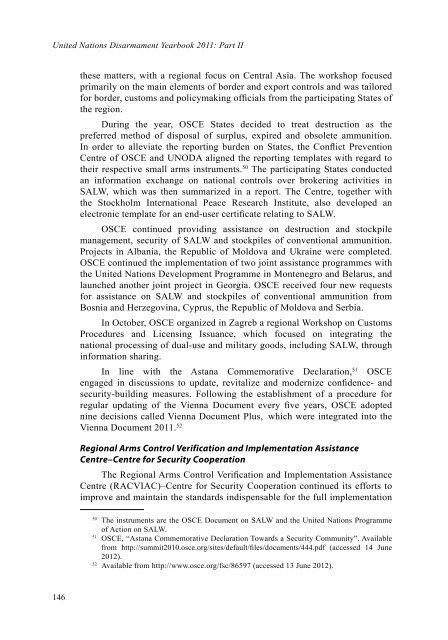DYB2011-Part-II-web
DYB2011-Part-II-web
DYB2011-Part-II-web
Create successful ePaper yourself
Turn your PDF publications into a flip-book with our unique Google optimized e-Paper software.
United Nations Disarmament Yearbook 2011: <strong>Part</strong> <strong>II</strong><br />
146<br />
these matters, with a regional focus on Central Asia. The workshop focused<br />
primarily on the main elements of border and export controls and was tailored<br />
for border, customs and policymaking officials from the participating States of<br />
the region.<br />
During the year, OSCE States decided to treat destruction as the<br />
preferred method of disposal of surplus, expired and obsolete ammunition.<br />
In order to alleviate the reporting burden on States, the Conflict Prevention<br />
Centre of OSCE and UNODA aligned the reporting templates with regard to<br />
their respective small arms instruments. 50 The participating States conducted<br />
an information exchange on national controls over brokering activities in<br />
SALW, which was then summarized in a report. The Centre, together with<br />
the Stockholm International Peace Research Institute, also developed an<br />
electronic template for an end-user certificate relating to SALW.<br />
OSCE continued providing assistance on destruction and stockpile<br />
management, security of SALW and stockpiles of conventional ammunition.<br />
Projects in Albania, the Republic of Moldova and Ukraine were completed.<br />
OSCE continued the implementation of two joint assistance programmes with<br />
the United Nations Development Programme in Montenegro and Belarus, and<br />
launched another joint project in Georgia. OSCE received four new requests<br />
for assistance on SALW and stockpiles of conventional ammunition from<br />
Bosnia and Herzegovina, Cyprus, the Republic of Moldova and Serbia.<br />
In October, OSCE organized in Zagreb a regional Workshop on Customs<br />
Procedures and Licensing Issuance, which focused on integrating the<br />
national processing of dual-use and military goods, including SALW, through<br />
information sharing.<br />
In line with the Astana Commemorative Declaration, 51 OSCE<br />
engaged in discussions to update, revitalize and modernize confidence- and<br />
security-building measures. Following the establishment of a procedure for<br />
regular updating of the Vienna Document every five years, OSCE adopted<br />
nine decisions called Vienna Document Plus, which were integrated into the<br />
Vienna Document 2011. 52<br />
Regional Arms Control Verification and Implementation Assistance<br />
Centre–Centre for Security Cooperation<br />
The Regional Arms Control Verification and Implementation Assistance<br />
Centre (RACVIAC)–Centre for Security Cooperation continued its efforts to<br />
improve and maintain the standards indispensable for the full implementation<br />
50 The instruments are the OSCE Document on SALW and the United Nations Programme<br />
of Action on SALW.<br />
51 OSCE, “Astana Commemorative Declaration Towards a Security Community”. Available<br />
from http://summit2010.osce.org/sites/default/files/documents/444.pdf (accessed 14 June<br />
2012).<br />
52 Available from http://www.osce.org/fsc/86597 (accessed 13 June 2012).


